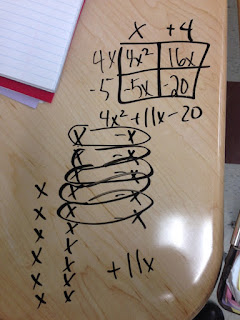Probability has to be one of my favorite units. There was no much time for it built into the learning schedule, but after the End of Course Exam (given six weeks before the actual end of course!), my students needed something lighthearted and fun - and this was the perfect unit. I started looking for something fun but different than the traditional "roll the dice and collect tally marks" activity, and I came across this
post from Sarah at "Math Equals Love" that linked me to "
Beano," which is described as "probability-based Bingo using legumes and a pair of dice." A few weeks ago a student found some dried beans in a board game, attempted to eat one and complained about how gross it was: A. why would you ever put an identified object from a board game box into your mouth? B. what would make you think dried beans would taste good? Needless to say, I ruled out the "dried legume" part, but the actual concept for the game sounded fun.

I had plenty of one centimeter cubes in a variety of colors, so I modified the game board with a fun font and a new name, and I decided to try it. To say this was a hit with my students is an understatement, they
LOVED Blocko!
I never once mentioned that the game had anything to do with math. I just told them we were going to play a fun game and explained the rules:

In the first few rounds we played with only six blocks. I rolled "
virtual dice" and called out the sum and the students removed their blocks when the sum was called. Several of my students didn't understand how this worked until they actually experienced a few rounds. Once they understood the rules, we played with all 12 blocks, and the winner won a Dum-Dum! I liked having groups of up to four students share one board (this is how the desks or arranged) because they can easily see how their strategy compares to others' strategies. Some of my students dropped their blocks onto the board to make it random, some spread them out onto each space every single time, and some students figured out which numbers had the highest probability of winning and won a lot of Dum-Dums. Everyone had fun!


We played this game in the last 10 minutes of class each day during our Probability Unit. During class on Thursday, I started collecting experimental data. I recorded the results of 10 games. During class today, we played the game again and I asked students if this data would influence how they placed their blocks. Some changed their strategy and some did not. One student said, "It looks like a mountain if you turn your head to the side" (great observation!) One student even collected his own data to see if it matched the class' data.

Several students stopped putting blocks on 2 and 12 and I asked them why. Some pointed to the experimental data, but I probed them to explain it in terms of outcomes. We then filled out a chart of possible outcomes and translated that to a dot plot
Student used this data and the experimental data to answer questions about their strategy, observations during the game, and how their strategy changed. I used some of the questions from the original "Beano" materials and added some of my own.
As students developed a strategy, the games finished much quicker and they were more competitive. (Each game took about four minutes - two minutes for block placement and two minutes of dice rolling) It was definitely a highly engaging game that I will look forward to each year. I hope your students like it too!
Download materials here.




































